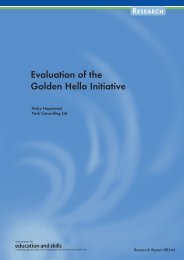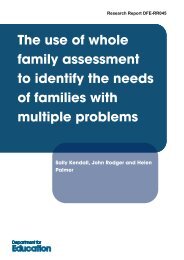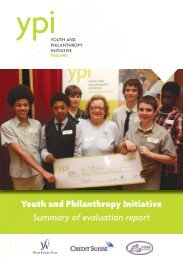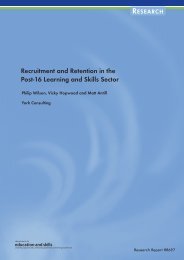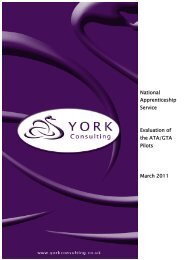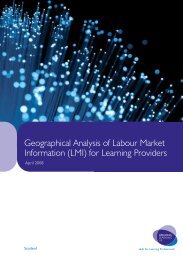Evaluation of a RIGHT blether - York Consulting
Evaluation of a RIGHT blether - York Consulting
Evaluation of a RIGHT blether - York Consulting
You also want an ePaper? Increase the reach of your titles
YUMPU automatically turns print PDFs into web optimized ePapers that Google loves.
Scotland’s Commissioner for Children and Young People<strong>Evaluation</strong> <strong>of</strong> a <strong>RIGHT</strong> <strong>blether</strong>Table 9: Views on the Five Elements <strong>of</strong> a <strong>RIGHT</strong> <strong>blether</strong>MEETThis was viewed as a valuable and influential strand, particularly bychildren and young people. Linking the Commissioner’s <strong>of</strong>fice and UNCRCto a real person helped young people to remember the rights and the role<strong>of</strong> the Commissioner: the vast majority could recognise the Commissionerinstantly and knew who he was. Suggestions were made that use <strong>of</strong>YouTube, videos and chat rooms, together with well-coordinated, areawideevents, could be more effectively employed for the Commissioner tointeract with young people without the need to be there in person. Somechildren and young people expressed disappointment that they wereunable to meet the Commissioner and a small number <strong>of</strong> adultshighlighted that some visits were arranged at short notice or that not allyoung people could go who wanted to.“Tam was interested in us” (Primary age child);“We got to be on a video broadcast!” (Primary agechild).This element was by far the most commonly employed strand. It wasperceived as a national, influential and fair activity by both children andyoung people and adults as it gave a large number <strong>of</strong> children and youngpeople a voice. It was most effective when prior work was undertaken (e.g.with the PARTICIPATE element) to inform children and young people aboutthe purpose and meaning behind the questions.“I think it provided an opportunity for real votingpower for children” (Primary depute headteacher).VOTEYoung people didn’t like the pre-determined nature <strong>of</strong> the questions andwere not aware that young people had been canvassed before votingcards were produced about what should go on them. There was theperception that questions could have been more relevant, especially forolder young people.“I felt that some <strong>of</strong> the questions did not address theissues young people face, or didn't give them anoption to suit them - perhaps questions and answerswould have been better suited than tick boxes <strong>of</strong>answers” (Community Learning and DevelopmentWorker).17



